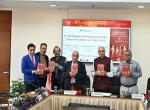The Vivekananda International Foundation (VIF), New Delhi in collaboration with the Indian Space Association (ISpA), New Delhi, organised a roundtable discussion on ‘India-US Space Engagements’ at the VIF on 10 July 2023. Director General (DG), ISpA, Lt Gen AK Bhatt (Retd) made the welcome remarks, while Director, VIF, Dr Arvind Gupta delivered the opening remarks. Senior government officials; representatives from private space companies and startups; and distinguished members from the strategic community participated in the roundtable discussion. The discussion covered a wide range of issues pertaining to the India-US space engagements, including space resources, space technologies, geopolitics of space, the Artemis accords, Outer Space Treaty (OST), moon agreement and strategic dimensions for India, India’s moon agenda, the NASA and ISRO space collaboration, export controls, launch of the iCET and INDUS-X initiative, and among others.
The world is in a new space age, where rapid development in space technology, cooperation and tensions between world powers are taking place. There are many space capabilities that have been developed, and thus many stakeholders have emerged. Earlier there were only few countries had space capabilities, but now new private players have come up in a big way as well, which would impact the OST, since private sectors are guided by the profit motive and ownership. It was noted that these developments are rapidly taking place in the ongoing geopolitics involving military and strategic technologies. However, the geopolitics of space sets apart as there is no defined geography. Instead, it is taking place at orbital paths and control areas like the Moon and comets. The geopolitics of space involves international space treaties, space laws, space resources, international collaboration and conflict in space exploration.
While the Outer Space Treaty of 1967 is a multilateral treaty on principles governing the activities of states in the exploration and use of outer space and other celestial bodies, including the Moon, and forms the basis of international space law. The Moon agreement of 1979 governs the activities of States on the Moon and other celestial bodies. Under the treaty, all states agree that the exploration and use of the Moon shall be carried out for the benefit and interest of all countries, irrespective of their level of economic or scientific development. It prohibits all States from claiming sovereignty over the Moon or any other celestial bodies. However, its implementation and legal status remain limited as major spacefaring nations, including the US have not signed it.
Whereas the Artemis accords is a US led initiative that lays out common principles, guidelines and practices for the safe exploration of the Moon by 2025, expands space exploration to Mars and beyond. It is designed to land the first woman and next man on the moon, and exploit its resources. It was noted that the US with this accords is leading a new era of space exploration, and trying to advance and maintain its dominance in outer space. It is expected that after the US initiative, Russia and China, who see the Artemis accords with suspicion, will also come up with their own space accords with competing programmes. Moreover, the Accords emphasizes that the extraction and utilization of space resources should be executed in a manner that complies with the OST and in support of safe and sustainable space activities. At present, the Moon’s South Pole is much in demand. In future, mineral rich areas would be in great demand. The one who reaches first conquers the area! Meanwhile, India officially signed the accords on 21 June 2023 and became the 27th country to do so. It was pointed out that India is a major spacefaring nation. Now, being part of the Artemis accords, it is driving the discussion, and would have significant technological and strategic value.
Notably, the space sector has opened up for an expanded and deeper India-US collaboration, which has witnessed significant growthin recent years. The two countries signed a landmark Civil Space Cooperation Agreement in 2008, which primarily focussed on Satellite Launches, Remote Sensing, and Earth observation. They have built partnership in various projects, including Chandrayaan-1, NASA-ISRO Synthetic Aperture Radar (NISAR), space situation awareness, and some cooperation in Chandrayaan-3. In a major breakthrough collaboration, the NASA-ISRO Synthetic Aperture Radar (NISAR) mission to co-develop and launch dual-frequency synthetic aperture radar (SAR) on the Earth observation satellite. After Russia, NASA has now agreed to provide advance training to the Indian astronauts for the Gaganyaan mission, ISRO’s first crewed orbital spacecraft. Under the iCET framework, the two countries have identified space as an important area of cooperation. They have also launched a new INDUS-X initiative, which primarily deals with bilateral defence issues, but it has space element as well. It was noted that India’s signing of the Artemis Accords is a landmark development and marked the beginning of a new phase in India-US space cooperation.
It was pointed out that the Artemis Accords is a geopolitical decision. But what needs to be looked at it as how does it affects India’s space autonomy; how does it affect ISRO’s space programme; how does it affect India’s space industry; and, what advantages it offers to India going forward. The question was raised whether India has given upa bargaining chipby joining the accords too early? It was underlined that in international relations, there are no permanent friends or permanent enemies, only interests are permanent. For India, its interests in the space domain should be of paramount importance. Nevertheless, India is now in the Artemis accords, it should be clear about its own priorities, cost and benefits, and should not wittingly or unwittingly become an appendage to the US discourse.
Importantly, the US export control laws come in the way of expanding bilateral space cooperation. In fact, the export controls have been major issue in the past that impeded bilateral technology cooperation, including space cooperation. There is almost no transfer of technology (ToT) and joint technology development, despite ISRO and NASA’s growing space collaboration. Thus, the two countries recently set up Strategic Trade Dialogue to address those existing export control regulations for further strengthening strategic technology partnership. After India’s signing of the accords, the US is willing to further ease its technology export controls for facilitating bilateral space collaboration. It was stressed that space collaboration should strengthen ‘self-reliant India’ programme, ToT, development of skills, talent and intellectual property (IP) rights among others. Nonetheless, it was observed that India is well positioned to utilise the arising opportunities to further strengthen its space programme, develop its space power for societal benefits and build mutual beneficial partnership with friendly foreign countries.







Post new comment